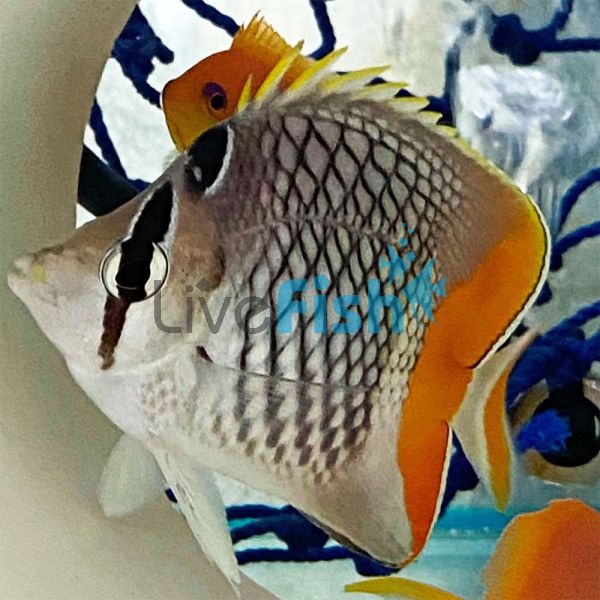Madagascar Butterflyfish MED
If you can't afford to visit the Seychelles, what can you do? With the graceful movements of Madagascar Butterflyfish, bring the Seychelles to your home aquarium.
The Madagascar Butterflyfish has dark grey chevron markings on the sides. It has a broad orange to reddish-orange band across the back of the body. It also has a black bar through the eye, and a pale-edged black patch on the forehead.
Butterflyfish are graceful in their movements and look, similar to the colourful winged insects from which they derive their name. These fish have a similar look to Angelfish, with laterally compressed bodies that allow them to sneak between rocky outcroppings and crevices in the coral reefs where they reside. Butterflyfish have a long snout with a small mouth that allows them to reach into cracks and crevices in search of the minute creatures they eat. There are roughly 120 species of Butterflyfish now known, but only a small number of them are suitable for keeping in a home aquarium.
Butterflyfish are among the most gorgeous saltwater fish you'll ever see, thanks to their vibrant colours and distinctive shape. Tropical climates are home to this fish, but they can also be found in cooler waters in the Pacific, Atlantic, and Indian oceans. However, they are primarily found in the Indo-West Pacific region.
Tank Recommendations for Madagascar Butterflyfish
This butterflyfish is quite hardy and would suit an intermediate aquarist with some experience. It requires a large, well-established aquarium. A 55-gallon or 208-litre tank is the smallest needed for a single fish, and a larger tank is needed if you intend to keep more than one. Decorate the tank with rocks and/or corals, as well as plenty of hiding places, whilst ensuring there is still plenty of swimming space. It swims freely and spends most of its time in open water or moving in and out of crevices.
It's a risk to keep this butterflyfish in a reef environment, as it can be a coral eater like many butterflyfish. Stony corals are relatively safe as long as the reef tank is large and well-stocked, and they are fed a proper and nutritious diet. It does, however, eat sponges and corals in the wild and may snack on live polyps, so keep an eye on it.
These fish should be housed in a well-maintained aquarium where they can "graze" algae from live rock and stones. If there isn’t enough algae on the rocks, it's important to feed more frequently and supplement with algae-rich food, such as Spirulina. This species enjoys swimming and necessitates a large aquarium.
Suitable Tank Buddies
These are peaceful fish, but they can be shy. They can be kept in a community tank with other peaceful inhabitants, but not with more aggressive fish, or they may hide and refuse to eat. Subdued lighting can aid in the initial acclimatization of more fearful individuals. They usually prove to be tough aquarium fish after a period of adaptation. More than one can be kept if introduced to the tank at the same time, and they can also coexist with other butterflyfishes.
Usually Compatible
Cardinalfish, Gobies, Tilefish, Fairy Basslets, Fairy and Flasher Wrasses, and other small, non-aggressive fish may be suitable tank mates. Smaller, more aggressive fish, such as Clownfish, Damselfish, and Anthias, also work well together. Angelfish such as Pomacanthus and Holacanthus, which are larger and more territorial, can be kept with this species. Other Angelfish species that can be tankmates include Centropyge, Apolemichthys, Genicanthus, Chaetodontoplus, and Pygoplites, Hogfish, Parrot Fish, Puffers and Tangs make excellent tank companions.
Sometime Compatible
In a coral-rich tank, the Madagascar Butterflyfish will nip coral polyps and snack on other invertebrates. It's best kept in a large fish-only community tank with plenty of hiding spots and rocks/corals. Batfish, Boxfish, Crustaceans, Dragonettes, and Triggerfish can sometimes compatible in a large enough tank.
Rarely Compatible
Butterflyfish are harassed or eaten by more aggressive fish such as Groupers, Snappers and Sharks are likely to eat your Butterflyfish. Seahorses and Pipefish are also not suggested as tank mates as they will compete for the same food sources and lose out to the Butterflyfish.
Feeding your Madagascar Butterflyfish
The Madagascar Butterflyfish is an omnivore that feeds on benthic invertebrates and algae in the wild. It is critical to feed a diverse range of foods in the aquarium to ensure they get a balanced diet. Provide a vitamin-enriched meaty diet, dried flakes, shrimps, tablets, and various frozen foods such as Formula I, Formula II, Angel Formula, and spirulina. Several frozen sponge-based foods are now available and can be fed to Butterflyfish. Nori from Japan will also be popular. Feed it at least twice a day, and three to four times a day if it is a tiny juvenile.
| Scientific Name | Chaetodon madagascariensis |
|---|---|
| Care Level | Moderate |
| Common Names | Seychelles Butterflyfish, Indian Ocean Chevron Butterflyfish, Pearlscale Butterflyfish, Pearly Butterflyfish, Pearscale Butterflyfish |
| Diet | Omnivore |
| Fish Family | Chaetodontidae - Chaetodon |
| Lifespan (years) | 5 |
| Max. Length (cm) | 13 |
| Min. Tank Volume (l) | 300 |
| Origin | East Indian Ocean, West Indian Ocean, Australia, Japan, The Red Sea, Indonesia |
| Reef Safe | No |
| Sociability | Peaceful |
| Venomous | No |
| Water Conditions | 72º-78ºF (22ºC- 25ºC),(dKH) of 8-12, pH of 8.1-8.4. |




